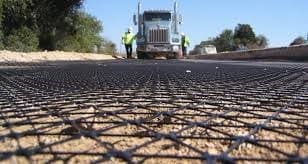NONWOVEN GEEOTEXTILE FABRICS are needle punched to provide the excellent strength and hydraulic characteristics necessary in ground stabilization, drainage and erosion control applications. The high elongation feature of the fabrics promotes a high survivability character.
Geotextiles enhance the performance and design life of granular layers by providing the separation & filtration function.
Geotextiles have superior properties such as Uniformity, High strength and elongation , superior wearing and abrasion resistant properties, Unique hydraulic capability with no delamination
Needle punched nonwoven fabrics are characterized by high porosity, elongation and energy absorption properties which make them ideal for a wide range of applications including subsurface, drainage, filtration, separation, and protection of liners.
Thermal bonding treatment imparts additional strength to the fabric which is particularly beneficial to ground reinforcement and separation applications.
The ability of Light Weight nonwoven needle punched Geotextiles is to restrict soil particles but allow water to easily pass through making it perfect for filtration and/ or separation applications.
Geotextile are manufactured with latest heat bonding process and intensive needling ensures that the fibres are fixed vertically resulting in an incredibly strong 3-dimensionaly stable geotextile fabric which has apprance like felt fabric No hazardous chemicals are used during production imparting them as ecological friendly in nature. The incineration of geotextile fabrics does not release any harmful gases only carbondioxide and water are formed which are both completely harmless
The most common nonwoven geotextiles is assembly of synthetic fibres, put together, which are mechanically & thermally bonded fabric of polypropylene and polyester fibres.
The major characteristics of nonwoven fabrics are their ability to withstand the climatic conditions. Provide resistance to acid alkalis and microorganisms, UV rays, and their reasonable elasticity enables them to withstand contraction & expansion in extreme climate. Geotextile are resistant to all naturally occurring soil alkalis and acids and fungal attack and UV stabilized in polypropylene geotextile fabrics.
The prime features, viz durability, ability to withstand the climatic conditions and other factors make our waterproofing protection suitable for varying purposes in the construction and roads. It provides stress relief, waterproofing and reduces reflective cracking functions in new and existing paved roads.
Various functions defined for geotextiles are reinforcement of walls/ sleep slopes, reinforcement of soft soil, reinforcement of concrete, asphalt roads, Erosion control and surfacial stabilization, confinement, impermeablization, Protection, Separation, Drainage, Filtration
Various applications of geotextile fabrics are for road construction, highway’s and highway embankments airport runways, shore protection in reclamation works, asphalt repaving of road, costal and riverbank revetment systems, filtration, drainage, composites, protection for geomembrance in landfills, Geobags manufacturing and siol erosion control
Recreational facilities from geotestile fabrics such as and race tracks to golf courses, fabrics are needed to keep layers of the structure separate and prevent contamination of customized surface by facilities oftenly use for economical reasons and for ease of installation permitting fast, simple construction.
Geotextile fabric in roll form is ideally suited for roads, landscaping applications and its permeability passage of air enhances its performance for sepration, protection, filtration, Drainage, Reinforement, stress relieving.
It is extensively used for construction of paved and unpaved roads, parking area, Railways, concrete floors
Fabric filter cloth is used for for filteration purpose for its features as perfect finish, high permeability, Tear resistance, Weight bearing capacity and easy installation.
Geotextile used for landscaping gardening suppresses weeds without application of chemicals and allows easy passage of water oxygen and nutrients while blocking the weeds and is installed at the interface between soil and decorative layers such as bark chipping, stone chippings, pebbles or gravel.
Polyester Geotextile fabric provides excellent solution for root shield because of its high tensile strength, high puncture resistance and is capable of withstanding the differential forces that can develop in clay soils. And can be used to protect as control barrier to protect buildings, walls, paths, access roads, drainage pipes and underground cables from root damage.
Geotextile Fabric are suitable for protection of impermeable membranes land fill areas, side walls and caps, reservoirs, balancing ponds, artificial lakes atc, to prevent soil erosion from beneath rock sheathing and pre-cast concrete revetments, sea shores, rivers and water channels, lakes and reservoirs etc. and application areas include Landfill Engineering, costal, Pipeline and Utility protection, and waterways highways, landscape, Road construction.
Paving Fabric used in paved & unpaved roadways made from polypropylene fibres that are heat bonded on one side to form a strong, flexible and dimensionally stable fabric structure. Resistance to chemicals and biological organism normally found in soil and is stabilised against degradation due to short term exposure to ultraviolet radiation, fabrics have optimum bitumen retention capacity, high tensile strengths and low elongation, allowing them to distribute loads, reduce rutting and extend the life of paved and unpaved roadways.
Geobags made from nonwoven geotextile of polyester and polypropylene fibre are used for hydraulic structures, protect revierbanks from soil erosion, scouring and flood control.
Geobags can be placed on dry land and can also be installed in to water of any depth using polypropylene gabions, nonwoven geobags are good filtrations as the pore size are small but the permeability is high, protects the terrestrial habitat, good abrasive resistance, fabric stability is more than in woven fabric, higher thickness which ensure good puncture resistance, Easily available, Implemented easily, easy to transport when empty, available in various sizes to fit specific application of design and installation. Geobags activities have minimal effect on the fish resources and in-turn also facilitate fishing activities. The overall methodology involves a systematic and multidisciplinary approach.
Geosynthetic Geotextile are offering the best solution for soil stabilization drainage marine, and environmental protection

